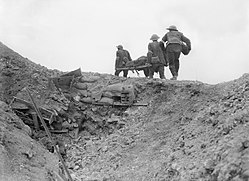Douglas Haig, 1st Earl Haig
Field Marshal Douglas Haig, 1st Earl Haig KT GCB OM GCVO KCIE ADC (born in Edinburgh on 19 June 1861, died in London on 29 January 1928) was a British Army general during World War I.
He was the senior commander of the British forces in France from 1915 until the end of the war. Most notably, he led it during the Battle of the Somme, the Third Battle of Ypres (Passchendaele), the Spring Offensive and the final Hundred Days Offensive.
Historians have often argued over whether Haig was a good general. In the years after the war, he was popular. After his death, some historians and politicians wrote books criticising Haig. They argued he made mistakes that led to a lot of casualties among British troops, especially at the Somme and Passchendaele. He has been nicknamed 'Butcher Haig' or 'the Butcher of the Somme'. David Lloyd George, the Prime Minister during the later years of the war, also did not agree with Haig.[1] One of the best known books criticising Haig was Alan Clark's book The Donkeys (1961). Thatis known as the 'lions led by donkeys' view: the idea that Britain had great soldiers but bad generals.[2]
However, some veterans, and academic historians have argued that Haig was a great general.[3] For example, John Bourne notes that Haig helped the army use new weapons and technology.[4] John Terraine argues that while the British Army lost many men, that is not surprising because of the size of the fighting, and other countries lost far more.[5] Likewise, Gordon Corrigan argues that as a percentage of the population, Britain lost half as many people in the war as France and Germany.[6]
Douglas Haig, 1st Earl Haig Media
Map of the Western Front in 1914.
Haig with Major-General C. C. Monro (commanding 2nd Division), Brigadier-General John Gough (Haig's chief of staff), and Brigadier-General E. M. Perceval (commanding 2nd Division's artillery) in a street in France, 1914.
Haig, King George V and General Henry Rawlinson at Querrieu, 1916
Memorandum from Haig to the Adjutant General, Lieutenant General Sir Nevil Macready, asking his opinion on possible dates for launching the Somme offensive, 22 May 1916
Stretcher bearers recovering wounded during the Battle of Thiepval Ridge, September 1916. Photo by Ernest Brooks.










